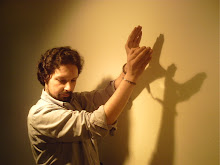 What is it about shadows that make them so fascinating? I've always been attracted by tonal contrasts, and the merging of opposites in a unity which transcends duality. Not surprising for a dyspraxic, I'm told. And here I am preparing a performance which combines storytelling, spoken word, performance poetry, live music and ... shadow theatre, based on The Arabian Nights. It draws together threads of East and West, of male and female gender games, darkness and light.
What is it about shadows that make them so fascinating? I've always been attracted by tonal contrasts, and the merging of opposites in a unity which transcends duality. Not surprising for a dyspraxic, I'm told. And here I am preparing a performance which combines storytelling, spoken word, performance poetry, live music and ... shadow theatre, based on The Arabian Nights. It draws together threads of East and West, of male and female gender games, darkness and light.We started out with the idea of puppetry - of a (female) puppetteer (Scheherezade) pulling strings of power which animate the male characters, but then it developed further, as a result of a rehearsal in which a serendipitous ray of sunlight lit up Sam's Daaf (see pic) and begged to have us use it as a shadow puppet screen, so we started exploring first shadow puppetry and then that gradually evolved into shadow theatre. The most telling difference between shadow theatre and shadow puppetry is that shadow theatre uses live performers. The visual impact is far more powerful - riding that edge of metaphysical contour between darkness and light, between fantasy and reality, specific and general. It's a powerful theatrical medium, with exciting possibilities, and it was only today that I realised I'd touched on the shadow of that power a year ago (in 2008) when I did a photo shoot for Aesop The Storyteller, a show I wrote about Aesop's life. In the pic, I used the metaphor of a hand shadow - a bird formed by two linked hands, stretched out in opposition, shackled at the wrists - a visual expression of a wish to be free. In the context of the story, in which Aesop started out as a slave, and became one of the best-loved free-thinking storytellers of all time, it worked.
Was this shadow really a spark of light which was to show me the way forward?


